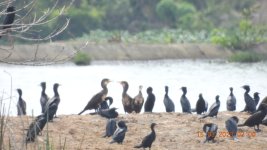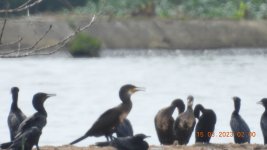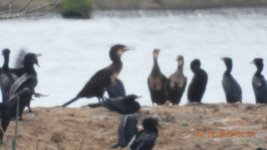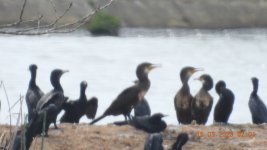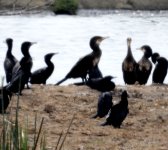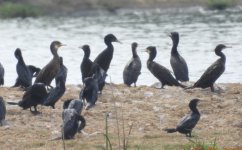Hi, in the attached photos there are several cormorants with quite a white throat patch and yellow gular skin. Apologies for the lack of sharpness in the photos but I think the side of the face and throat and gular skin come through clearly enough . Which I think suggests Great Cormorant. However, the heads of these birds are quite round, which suggests Indian. Indian is uncommon and Great, at least recently, would be quite rare. In the last photo (188c) there is one to the right with that facial colouring and a flatter head, but the one in the center appears to me to bee quite round
. Which I think suggests Great Cormorant. However, the heads of these birds are quite round, which suggests Indian. Indian is uncommon and Great, at least recently, would be quite rare. In the last photo (188c) there is one to the right with that facial colouring and a flatter head, but the one in the center appears to me to bee quite round
There are a number of these, amongst a flight of Little Cormorants and I think some black faced Indian (just to the left of the "centered" questionable cormorant with the round head and relatively large size ). Can Indian Cormorants in non-breeding plumage show so much white and yellow? Nothing in my field guides or in looking through Macaulay images suggests that. But the heads are clearly not flat either. So I am stuck If pressed, I would say Indian, but I then would be unable to explain why the face/neck/gular colouring.
If pressed, I would say Indian, but I then would be unable to explain why the face/neck/gular colouring.
Taken March 15, 2023 in a very large marshy and diked area in Songkhla Province, South Thailand.
Thank you very much in advance for your comments and corrections to my line of thinking.
steve
There are a number of these, amongst a flight of Little Cormorants and I think some black faced Indian (just to the left of the "centered" questionable cormorant with the round head and relatively large size ). Can Indian Cormorants in non-breeding plumage show so much white and yellow? Nothing in my field guides or in looking through Macaulay images suggests that. But the heads are clearly not flat either. So I am stuck
Taken March 15, 2023 in a very large marshy and diked area in Songkhla Province, South Thailand.
Thank you very much in advance for your comments and corrections to my line of thinking.
steve




